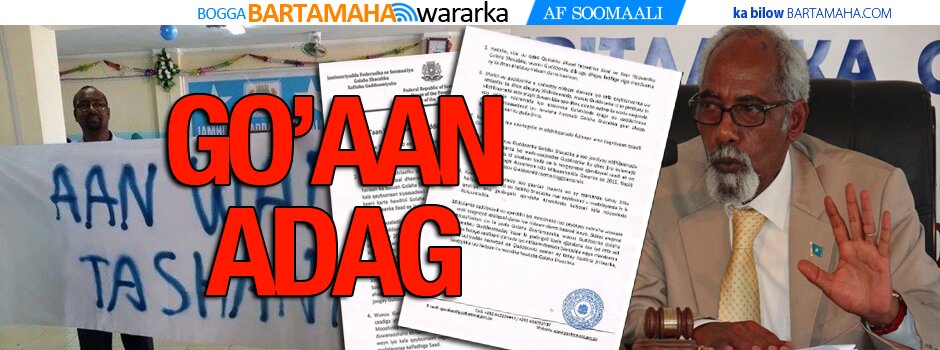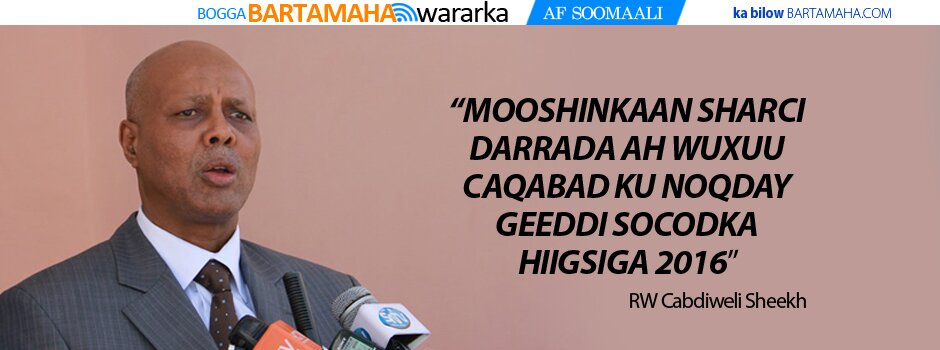The Roots of the Islamic Conflict in Somalia

Dr Abdirahmaan Badiyoow.
Somali people will commemorate this month, the 50th anniversary of their independence, divided and fighting on the meaning of Islam and Shari’a. The aftermath of 9/11 events and the emergence of the Islamic Courts in 2006 ushered new political reality in Somalia. Jihadist Al-Shabab linked to al-Qa’ida dominates large parts of fertile regions of the Southern Somalia while Transitional Federal government remain hauled under the protection of AMISOM. Amazingly, both the government and its armed opposition claim their strong adherence to Islam and readiness to the application of Shari’a. The prominence of the Islamic discourse that supposedly had to promote peace and brotherhood and continuos in-fighting in the name of Islam puzzles many and demands explanation. This article attempts to sheds some light on the three major trends of Islam in Somalia putting the finger where the current conflict in the name of Islam lies.
1. Traditional Islam
There are no disagreement between main stream Muslims that basic sources of Islam are the Qur’an and the Sunna of the Prophet. However, these sources were interpreted by various scholars in different times and spaces and produced various schools of thought in theology and jurisprudence. Moreover, Sufi Orders strongly appeared in the Muslim world since 9th century and took greater role in spreading Islam particularly in Far East Asia and Africa. When the message of Islam reached many nations with diverse cultures, some elements of their cultural norms and customs were considered part of the Islamic jurisprudence. Also, some un-Islamic elements of these cultures were accommodated by some Sufi Orders. Regarding Somalia, Islam follows three main persuasions: Ash’ariyah theology, Shafi’i Jurisprudence and Sufism. Thus, Somali society espouses taqlid (imitation) and follows strictly these three persuasions. Besides that, these three persuasions are preserved through traditional Islamic institutions comprising educational establishments and centres of the Sufi Orders where a master-disciple intimate relationship is nurtured. This relationship is the core foundation of Sufism and preserved through various social functions. The most important functions are “Mawliidka†(commemoration the Prophet’s birth day), “Xuska†(offering charities to the soul for the deceased parents) and “Siyaaro†(offering homage to the respected teachers and visiting their tombs).
The Ash’ariyah theology (Al-caqiida) adhered by the Somalis was founded by Abu al-Hasan Al-Ash’ari (873–935) in reaction to the extreme rationalism espoused by the school of Mu’tazilah. The Ash’ari theology and its methodology were accepted as the standard for mainstream Sunni theology by the scholarly community in their own times and in every generation afterwards. It was mainly based on to defend Islam from the extremes of excessive literalism and excessive rationalism, maintaining the middle and moderate way of Islam. Without getting into further discussion, just to point out the nutshell of the debate, the most controversial issues are how to comprehend the divine attributes and the way of consigning the meaning to Allah. The preferred position of the Ash’ari theology is based to affirm what attributes Allah has affirmed for himself and negate what Allah has decisively negated for himself, which is any similitude whatsoever between the Creator and creation as affirmed by “there is absolutely nothing like unto Him..†(42:11).
One of the prominent scholars of Ash’ rites is Abu-Hamid al-Ghazzali (1058–1111) who articulated moderate Sufism combining it with al-Ash’ariyah theology. Sufism in Somalia belongs to that moderate Sufism rooted in the Al-Ghazali way and exercises significant missionary impact all over Somalia. Its tremendous influence is conducted through its two main brotherhoods: Qadiriyah and Ahmadiyah (Salihiyah is a branch of Ahmadiyah). Somalia also adheres to the Shafi’i school of Jurisprudence, one of the main four schools of Sunni jurisprudence. This is the nature of Islam adhered by the overwhelming majority of the Somalis and advocated by the Sufi Orders and Ahl Al-Sunna wa Al-Jama umbrella organization. The shortcoming of the traditional Islam is the lack of agenda to effectively counter secularism and westernization in the Muslim societies, the gap that modern Islamism claim to fill.
Modern Islamism in Somalia
Modern revival of Islam addresses multiple strains in the society inflicted by colonialism and modernity. Its proponents advocate application of Shari’a in all aspects of life and snub secular idea of the state. Streams of ideas and groups belonging to this category are numerous and diversified. However, in Somalia, two main conceptions of Islamism are more visible. These are Salafism represented mainly by Al-Itihad and Muslim Brotherhood represented mainly by Islah. Here, it is relevant to explore their core ideas in relation to the traditional Islam.
a. Salafism versus traditionalism.
Salafism in Somalia stands completely opposite to the traditional Islam. Its adherents identify the primary obstruction that caused the decadence of the Muslims is the pernicious innovations (bida’) introduced to Islam. Therefore, in placing overriding emphasis on preaching idealized “Tawhid†(monotheism), they always focus their condemnation on many traditional Muslim practices as innovations and “shirk†(polytheism). This school adheres to what is termed Salafia theology, which arrived to Somalia with the increased influence of Saudi Arabia through students educated in its Islamic universities and migrant labor. These students learned the teachings of Sheikh Mohamed Abd Al-Wahhab, often referred to by adherents as Salafi and Wahhabi by its detractors.
Adherents of Salafia theology in Somalia also introduced some elements of Hanbali Jurisprudence learned in Saudi schools and replaced it in the public spaces with the predominant Shafi’i jurisprudence. This undertaking created conflict between Salafism and traditional Islam. Moreover, they consider their principal duty to be spreading “al-Aqidah al-Sahiha†(the right theology) considering Ash’ariyah theology as inaccurate. Accordingly, they believe that their theology is the only right one because it is the theology of the first three generations of Muslims where they draw their name “al-salafia†(followers of the early pious generations of the Muslims). This mode of thinking breeds intolerance, internal conflict and extremism. Moreover, the Salafis consider Sufism a dangerous heresy and are engaged in an uncompromising conflictual campaign against them. In that way, Salafism, as projected in Somalia, is not a reform movement, but a revolutionary approach that aims to obliterate and completely change traditional Islam as practiced in Somalia. This stream of thought is followed by Al-Itihad and its derivatives like Al-Itisam, Al-Shabab, Hizb Al-Islam and others. Even though Salafism in Somalia are not monolithic, its extreme version is evident in the destruction of the tombs of the prominent Sufi scholars and its desecration. Often, within Salafi ideology, Takfir ideology permeates which permits its adherents to easily kill other Muslims in simple pretext of labeling them “apostatesâ€. This combined version of Salafism and Takfir is highly evident in Al-Shabab belief and practices.
b. Muslim Brotherhood versus traditionalism
In the middle of the traditional Islam and Salafism stands Muslim Brotherhood that adopted the slogan “we should unite upon that which we agree, and excuse each other in that which we disagree.†The tolerance of the Muslim Brotherhood emanates from its worldwide program based on the gradual reform of the Muslim societies. These Muslim societies adhere to different schools of Jurisprudences, theologies and various forms of Sufism. Hassan al-Banna, the founder of the Muslim Brotherhood in 1928 wrote that “differences on the branch matters of Islamic Jurisprudence should not be allowed to cause division, contention, or hatred within the ranks of the Muslims.†In that context, followers of Muslim Brotherhood methodology avoid divisive Islamic discourses on the doctrinal matters and legal aspects within its society. Being open to the diversity of Islamic theology and practices, they are tolerant to the different theological views on Islam and deplore rigid preoccupation with minor nuances of religious doctrine. They believe that Sufism and other traditional practices should be accommodated and that focus in the Islamic activism should be directed toward social and political issues rather than on theological hair-splitting. This means that Muslim Brotherhood does not contravene with the Ash’ari theology, Shafi’i Jurisprudence and Sufism, which constitute the basic components of the traditional Islam in Somalia. However, they work to purge un-Islamic practices in the societies through educational process in a tolerant atmosphere that does not ruin community cohesion and avoids religious disputes. Its main program is to create an environment of cooperation between various Islamic groups and organizations in the benefit of the bigger goal, the Islamization of the society and the state.
Concluding, the three Islamic trends – traditional Islam, Salafism and Muslim Brotherhood- are present in Somalia. These Islamic orientations at times confuse the public and non-experts who lump them as monolithic Islamists (wadadadda, Islamiyiinta). Nonetheless, while Sufi Orders and Muslim Brotherhood are tolerant, Salafism is confrontational. It has engaged in bloody confrontations with clannish factions in 1991, 1992 and 1995-7. The last case of their confrontation is the war between Al-Shabab and Hizbu Al-Islam on the one hand and Ahl Al-Sunna wa Al-Jama representing traditional Islam on the other. Indeed, the roots of the Islamic conflict in Somalia lies with the ideology of Salafism as practiced in Somalia!
By Abdurahman M. Abdullahi (Baadiyow)
Comments
comments
 Calendar
Calendar





































